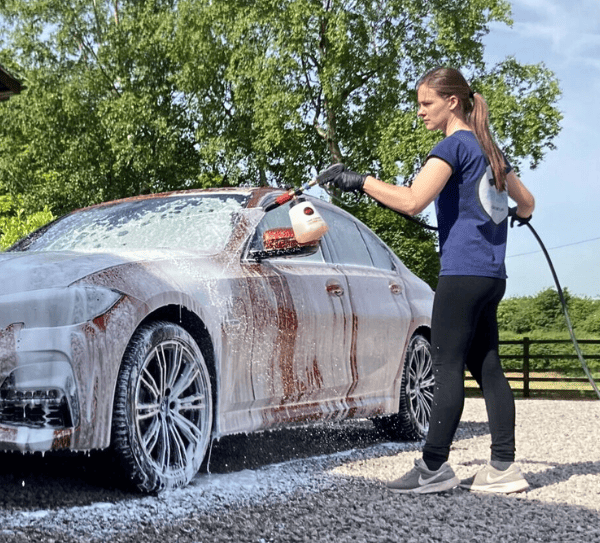If you’re getting into car detailing, then you’ve probably heard a little bit about iron removers. The premise is, that iron fallout and brake dust can bond to your car’s paint and alloys, and iron removes dissolve these iron particles to give your car a smoother and shinier finish. But is this actually necessary?
In this article, I’ll be discussing the pros and cons of iron removers and helping you decide if you actually need to use them on your car or if they’re just a gimmick. So let’s get started.
The Quick Answer
Iron fallout removers are an essential step when decontaminating your car’s paintwork and alloys before paint correction and protection. Iron removers are usually used at least every 6 months on alloys and at least annually on paintwork for best results.
What are Iron Fallout Removers?
Iron removers are pretty self-explanatory. They dissolve iron contamination from your car’s surface. They can sometimes be referred to as “bleeding iron removers” because they react with the iron contamination and turn purple.
Iron fallout contamination is usually invisible but it can cause the paintwork to feel rough and may be noticeable in more severe cases on cars with light-coloured paint. It can accumulate on the paint from several sources including the brake discs or from industrial plants or railways.
There are several main steps to making your car look it’s best. Iron removers are part of the decontamination step of detailing.
- Washing
- Decontaminating
- Paint correction
- Paint protection
There are two types of decontamination, chemical and physical.
Iron removers fall into the chemical decontamination step.
Physical decontamination on the other hand, involves either a clay bar or clay mitt. You glide this over the surface of your paint and it helps to remove contaminants bound to the surface.
These contaminants include things like road tar, bugs, tree sap and bird mess that’s bound to the paint so strong that it can’t be removed by normal washing.
It’s pretty easy to check for these type of contaminants. If it feels rough, then there are contaminants bound to the surface.
Looking for some of the best products to decontaminate your car? Make sure you check out my recommended products page for all my current top picks.
Do you Need to Use an Iron Remover?
Okay, so this leads us to the big question, are iron removers actually necessary.
Personally, I think it’s important to use an iron remover to get rid of any fallout on your car because it can corrode the surface over time and causes it to feel rough.
Some people skip the iron fallout removal spray stage because they expect a clay bar to take care of instead. However, there are two issues with this school of thought:
- The iron particles are abrasive so can mar and scratch the paintwork when removed using clay. Using an iron fallout remover first helps to reduce the chance of inflicting clear coat damage.
- Clay is not always completely effective at removing iron fallout so for best results, a dedicated spray is recommended.
How Often Should You Use an Iron Fallout Remover?
There are areas of your car that are a lot more prone to iron fallout than others. Namely, behind the wheels as this is where the brake dust is more likely to settle on the paint. So using an iron remover on these areas more frequently can be beneficial.
Using an iron fallout remover once to twice per year is usually sufficient for most vehicles. However, it may be required more frequently if the vehicle is driven very often. In most cases though, using an iron fallout remover more than 3-4 times per year is unnecessary.
I do however, think it’s important to use an iron remover on your car’s alloys more regularly. This should be done twice a year but maybe even more often if the car is driven very frequently.
Brake dust builds up on your alloys very quickly, and if left to sit there for longer periods of time, it can be incredibly difficult to remove and cause corrosion.
So it’s important to keep on top of this by using an iron remover on your alloys regularly.
How to Use an Iron Fallout Remover
Make sure you always follow the manufacturer’s recommendations for the use of any product on your car. However, here is a quick guide to using an iron fallout remover which applies to most products:
- Wash the car thoroughly
- Rinse and dry the vehicle
- Spray the iron fallout remover all over the paintwork and wheels
- Allow to dwell for the recommended time (usually 2-5 minutes) but do not allow to dry. You should see tiny spots of red/ purple indicating that the reaction is occuring.
- Rinse the product away thoroughly with a pressure washer
- Dry the car and use the iron fallout remover again on a small section (the front door or rear bumper is a good place to test) to see if the reaction occurs again. If it does, repeat on the entire car.
- Rinse the product with pressure.
- Wash the car again with a wax-free shampoo to ensure all product residue is removed.
- Dry the car or proceed with another decontamination step (tar removal or clay).
Frequently Asked Questions
Don’t worry if you still need some more answers about iron removers. Here are the answers to some most commonly asked questions about iron removers.
Does iron remover remove wax?
Iron removers can degrade the wax on your car and decrease the durability if used frequently. Therefore, I recommend only using an iron remover on the paint as part of a full detail where you intend to apply paint protection afterwards.
Does a clay bar remove iron contamination?
Clay bars can remove some iron fallout. However, iron particles are very small, so can be missed by the car bar. That’s why it’s important to use both chemical (iron fallout and tar removers) and physical (clay bar) decontamination techniques.
Check out my article on this topic to learn more.
Should you use an iron remover before or after claying?
You should use an iron remover before claying your car. Iron removers help to get rid of as much iron as possible before using physical decontamination methods like clay which is safer for the paint.
Clay is an abrasive so you run the risk of scratching your car when using it. This risk is increased when there are more contaminants bound to your paint because the clay bar will get dirty faster and this can get rubbed into your paint inflicting clear coat damage.
Using an iron remover gets rid of as much contamination as possible before you touch the paint with clay, hence it reduces the risk of scratches and swirls.
What is the active ingredient in iron fallout remover?
The active ingredient in iron fallout remover is thioglycolic acid which turns purple or red when it reacts with iron. Warning though, it smells pretty terrible and you should avoid breathing it in. Use it in a well ventilated area, use a protective mask and wear gloves.
What is the best iron fallout remover?
Bilt Hamber Korrosol is a great quality iron fallout remover that is excellent value for money. There are plenty of other options available as well. I personally have used Auto Finesse Iron Out and AutoGlym Magma as well which are good quality.
Thanks for reading! I hope you’ve found this article helpful. Don’t forget to check out the rest of the blog to learn more about getting your car looking its best.

